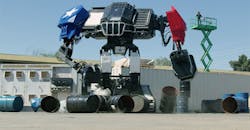I am not interested in destruction. In fact, I have a thorough distaste for violence in general. Which makes our continual coverage of MegaBots and its giant fighting machines an odd fit.
I am, however, extremely interested in creativity, in gumption, and innovation. And that—even with the destruction and violence—is exactly what Megabots is offering.
We started covering MegaBots in 2015, with the Mk. II gracing our October 2016 cover. At the time, that project felt like the pinnacle achievement of the maker movement: two dudes with some skills, a small team, and financial backing built a legit giant fighting robot. Sure, it was rough; the mechanics were a little crude, and the whole project seemed a bit DIY. And that was great. That's exactly what the maker movement is all about, right?
It's a project I often highlighted in my talks about makers and innovation. A giant killer robot created ex nihilo by a couple of guys with a good idea.
Traditionally, that's where the story should have ended. But it did not.
Here we are again a year later with a whole new robot, a whole system that doesn't seem DIY at all. It's a 16-ft-tall real giant fighting robot backed by a giant team, a giant pile of resources, and some of the very best equipment and knowhow in the industry.
So what happened?
Collaboration happened.
This is no small achievement. It's something we've been trying to unlock in the manufacturing industry for decades. Formally, the U.S. has been trying to accomplish this through Manufacturing USA (or the National Network for Manufacturing Innovation) since 2014.
The idea is simple: the U.S. is filled with some of the smartest manufacturing and design engineers in the world, all of them siloed in competing companies and universities where genius is forced to remain hidden and proprietary.
If we're going to fully address the challenges facing the industry today—from new uses for industrial 3D printing to energy storage to smart manufacturing—it makes a lot of sense to break down those walls and bring that genius together.
That's a hard sell, though. And for those of us cheerleading the movement, it's been a long and anxious wait for tangible results.
But then the Mk. III rolls in on its armored tracks from Howe and Howe Technologies, swinging killer arms powered by Parker, and held together by Lincoln Electric welds. And it suddenly seems like something might be starting to happen.
Sure, it might be for an extremely niche project and a long-shot new extreme sport. But looking at the Mk. II and the Eagle Prime robots side-by-side, the potential for industrial collaboration seems pretty obvious.
When we step aside from competition and market advantages for a minute and focus our energies on creating something legitimately cool, something profoundly innovative and groundbreaking, the results will amaze the world.
And as we clamor to find our footing again as a global manufacturing leader, this one project gives me the most hope. Even if it is just a giant fighting robot.
About the Author
Travis Hessman
VP of Content, Endeavor Business Media
Travis Hessman is the VP of Content for Endeavor Business Media. Previously, Travis was the Editor-in-Chief for Industry Week and New Equipment Digest as well as the Group Editorial Director for Endeavor's Manufacturing Group.
He began his career as an intern at IndustryWeek in 2001 and later served as IW's technology and innovation editor. Today, he combines his experience as an educator, a writer, and a journalist to help address some of the most significant challenges in the manufacturing industry, with a particular focus on leadership, training, and the technologies of smart manufacturing.


